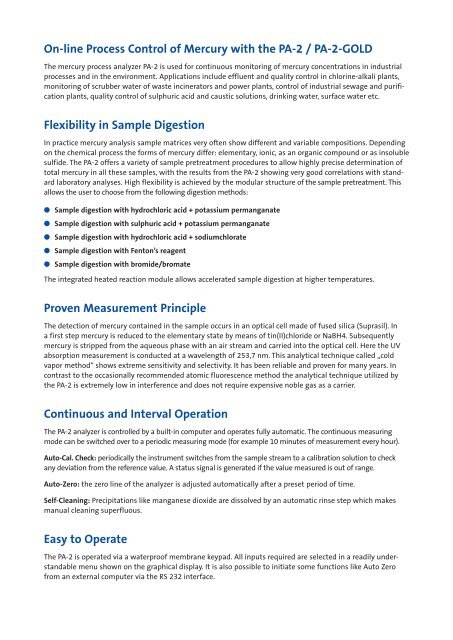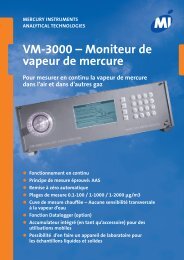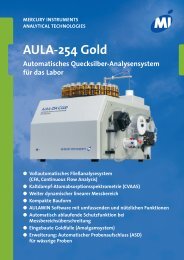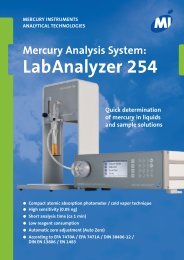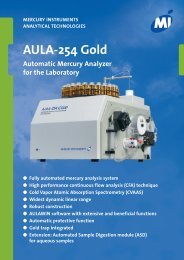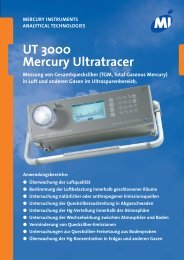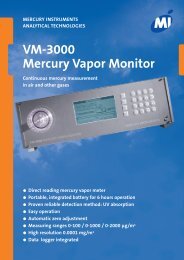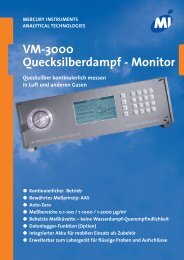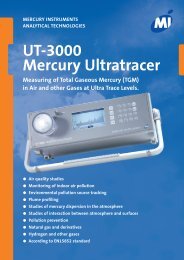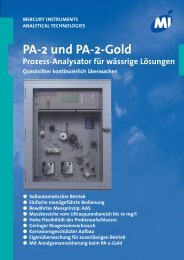PA-2 Process Analyzer for Aqueous Solutions - Mercury Instruments ...
PA-2 Process Analyzer for Aqueous Solutions - Mercury Instruments ...
PA-2 Process Analyzer for Aqueous Solutions - Mercury Instruments ...
You also want an ePaper? Increase the reach of your titles
YUMPU automatically turns print PDFs into web optimized ePapers that Google loves.
On-line <strong>Process</strong> Control of <strong>Mercury</strong> with the <strong>PA</strong>-2 / <strong>PA</strong>-2-GOLD<br />
The mercury process analyzer <strong>PA</strong>-2 is used <strong>for</strong> continuous monitoring of mercury concentrations in industrial<br />
processes and in the environment. Applications include effluent and quality control in chlorine-alkali plants,<br />
monitoring of scrubber water of waste incinerators and power plants, control of industrial sewage and purification<br />
plants, quality control of sulphuric acid and caustic solutions, drinking water, surface water etc.<br />
Flexibility in Sample Digestion<br />
In practice mercury analysis sample matrices very often show different and variable compositions. Depending<br />
on the chemical process the <strong>for</strong>ms of mercury differ: elementary, ionic, as an organic compound or as insoluble<br />
sulfide. The <strong>PA</strong>-2 offers a variety of sample pretreatment procedures to allow highly precise determination of<br />
total mercury in all these samples, with the results from the <strong>PA</strong>-2 showing very good correlations with standard<br />
laboratory analyses. High flexibility is achieved by the modular structure of the sample pretreatment. This<br />
allows the user to choose from the following digestion methods:<br />
● Sample digestion with hydrochloric acid + potassium permanganate<br />
● Sample digestion with sulphuric acid + potassium permanganate<br />
● Sample digestion with hydrochloric acid + sodiumchlorate<br />
● Sample digestion with Fenton’s reagent<br />
● Sample digestion with bromide/bromate<br />
The integrated heated reaction module allows accelerated sample digestion at higher temperatures.<br />
Proven Measurement Principle<br />
The detection of mercury contained in the sample occurs in an optical cell made of fused silica (Suprasil). In<br />
a first step mercury is reduced to the elementary state by means of tin(II)chloride or NaBH4. Subsequently<br />
mercury is stripped from the aqueous phase with an air stream and carried into the optical cell. Here the UV<br />
absorption measurement is conducted at a wavelength of 253,7 nm. This analytical technique called „cold<br />
vapor method“ shows extreme sensitivity and selectivity. It has been reliable and proven <strong>for</strong> many years. In<br />
contrast to the occasionally recommended atomic fluorescence method the analytical technique utilized by<br />
the <strong>PA</strong>-2 is extremely low in interference and does not require expensive noble gas as a carrier.<br />
Continuous and Interval Operation<br />
The <strong>PA</strong>-2 analyzer is controlled by a built-in computer and operates fully automatic. The continuous measuring<br />
mode can be switched over to a periodic measuring mode (<strong>for</strong> example 10 minutes of measurement every hour).<br />
Auto-Cal. Check: periodically the instrument switches from the sample stream to a calibration solution to check<br />
any deviation from the reference value. A status signal is generated if the value measured is out of range.<br />
Auto-Zero: the zero line of the analyzer is adjusted automatically after a preset period of time.<br />
Self-Cleaning: Precipitations like manganese dioxide are dissolved by an automatic rinse step which makes<br />
manual cleaning superfluous.<br />
Easy to Operate<br />
The <strong>PA</strong>-2 is operated via a waterproof mem brane keypad. All inputs required are selected in a readily understandable<br />
menu shown on the graphical display. It is also possible to ini tiate some functions like Auto Zero<br />
from an external computer via the RS 232 interface.


